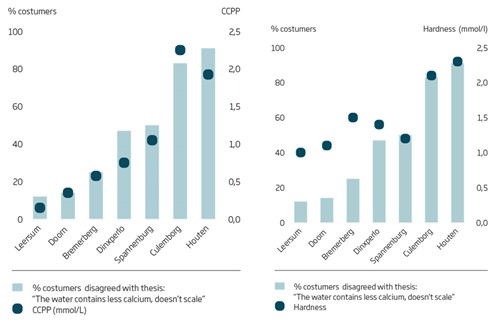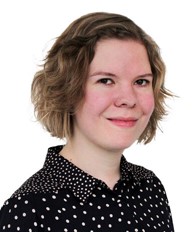Insight
Softening is a challenging paradigm shift for Danish utility providers

Columns for softening at Brøndbyvester Vandværk. Photo: HOFOR
Insight
Columns for softening at Brøndbyvester Vandværk. Photo: HOFOR

There are no good standard solutions in the change, which several utility providers are about to make. We can look to an extent at foreign experience of water softening, but a holistic response is to be found in customised solutions for each particular waterworks.
A number of Danish utility companies have made a big decision. They now intend to introduce water softening on a large scale. Other utility companies are considering softening, but have not yet 'pressed the button.' All eyes are on HOFOR, Tårnby Forsyning and St. Heddinge Vandværk, who will be establishing softening during summer 2017.
Undoubtedly, there are decision-makers in the country's utility companies, who are well and truly in doubt.
"There is no point in choosing a technology that requires weekly operation if softening is to be implemented in a small-scale waterworks, which is not usually staffed."
Camilla Tang
Establishing softening in Danish waterworks is a radical change, when compared to the relatively simple water treatment used in most waterworks, because the Danish groundwater makes it possible.
Embarking upon softening is a major decision, and once that decision has been made, a huge number of questions arise: What technology should we use? To what degree of hardness should the water be softened? How best to implement softening in the existing water treatment process?
There are a variety of technologies for softening. Some, for example ion exchange, are familiar in industry, while the pellet method is brand new in Denmark.
It takes a holistic approach to choose the most suitable softening technology, thereby ensuring the utility company the maximum environmental and socioeconomic gains as a result of softening. That is why there is no standard solution that will suit any waterworks, and there are a lot of conditions to take into account, when utility companies want to implement softening.
For example, the holistic way of thinking may come into play when considering the degree of hardness, to which the water has to be softened. Choosing the optimum hardness is a balancing act, in which, on the one hand, consumers want the softest water possible to avoid the precipitation of lime on household appliances and in the bathroom. On the other hand, it is important not to soften the water too much, because it can then become corrosive, thereby causing damage to pipelines in the distribution network or in households.
It is not only about hardness. In Denmark we generally calculate the hardness of water in German hardness degrees: °dH. These are calculated on the basis of the content of calcium and magnesium in the water. The hardness in Denmark varies from soft ((4-8 °dH) in West and Central Jutland to extremely hard (> 30 °dH) in the Capital Region. Central softening of drinking water is only worth implementing in areas with hard water. Danish socioeconomic analyses, which compare the effect of different softening technologies in households, assume that water is softened from a particular initial hardness to a particular final hardness. However, there is a difference in how the different technologies affect the quality of the rest of the water. The water's bicarbonate content is particularly important in terms of how inconvenient the precipitation of lime is for consumers.
In the Netherlands, where utility companies have been softening water since the 1970s, in recent years they have very much started to include other parameters in the definition of water's hardness.
For example, there is the Calcium Carbonate Precipitation Potential (CCPP) parameter, which expresses the amount of lime that can theoretically deposit in, say, consumers' homes, and is calculated on the basis of the entire carbonate system. Two types of water with the same hardness may have different CCPPs, so consumers will experience the water differently.
"It is important for utility companies to be involved in the implementation of softening, so the solution does not work on paper alone."
Camilla Tang
A consumer survey conducted by the Dutch utility company, Vitens shows that the degree of inconvenience, which consumers experience from lime precipitation, relates far more to the CCPP than to the degree of hardness of the water.
Accordingly, if the purpose of establishing softening is to give consumers an optimal experience of less lime in the bathroom and the kettle, we should clarify the traditional division of "hard" and "soft" water on the basis of German hardness degrees and look, for instance, at parameters such as the CCPP.

The graphs show the results of a consumer survey conducted by the Dutch utility company, Vitens. The study reveals a clear connection between the CCPP and consumer satisfaction (left), whereas the hardness of the water does not always play a role in the extent, to which consumers experience inconvenience from lime (right).
It is possible to design an optimal softening process on the drawing board, but there may also be practical considerations that may be crucial when it comes to how softening can be implemented, particularly in existing waterworks. These might include the size of the available building site or whether the waterworks is connected to the sewage system, because several softening technologies generate a lot of waste water.
There is no point in choosing a technology that requires weekly operation, if softening is to be implemented in a small-scale waterworks, which is not usually staffed. Consequently, it is important for utility companies to be involved in the implementation of softening, so the solution does not work on paper alone, but is also adapted to the practical challenges a waterworks may face.
Central softening is a radical change in the way we treat drinking water in Denmark. We can start with experience from countries such as the Netherlands, Sweden and France, where softening has already been implemented, but we also have an opportunity to combine existing solutions with the latest knowledge of, say, water chemistry.
That means we can ensure that our society and the environment achieve the maximum benefits from central softening. We can also make sure that both large and smaller utility companies are given holistic solutions that work on the particular terms of each waterworks.
HOFOR intends to utilise the pellet method for softening the capital's drinking water. The method was developed in the Netherlands. To put it simply, the water is passed through a high column, in which a base and sand grains are added to the water. This causes the lime to crystallise and to stick to the sand grains. The pellets of lime grow bigger and bigger until they settle and can be removed. Finally, the water is neutralised again, for example using CO2.

Camilla Tang
Discipline Manager
Allerød, Denmark
Camilla Tang conducts research into water softening. She studied Master of Science, specialising in Environmental Technology, at DTU, graduating in 2016. Her thesis on softening received several awards: for example, for the best student project at the VandTek trade fair that same year. In 2017 she started her PhD in collaboration with DTU Environment, HOFOR and NIRAS. Her research project sets out to develop the basis for a decision-making tool, which utility companies can apply, when choosing an optimal softening solution.
Contact
